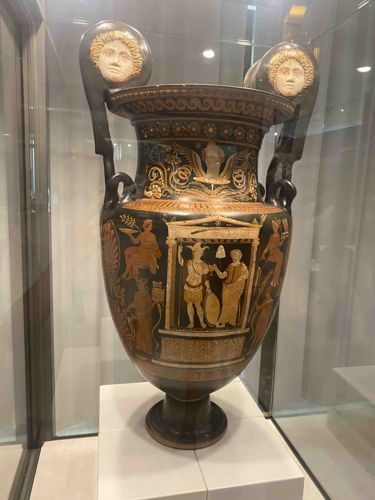
Ancient Greek Volute Krater with Figural Masks and Mythological Scenes
This is a large, elaborate Greek volute krater, a type of vessel used for mixing wine and water. The krater is predominantly black-glazed with significant areas left in the natural terracotta color or painted with details in red-orange, white, and possibly yellow, indicative of the typical Attic red-figure or black-figure techniques from antiquity, though here it appears to be primarily black-figure with added colors and details. Its robust physical characteristics include a wide mouth with a flaring lip, a substantial body tapering towards a footed base, and two prominent, ornate volute (scroll-shaped) handles. Each handle terminates in a finely molded three-dimensional mask of a male figure, likely a deity or a mythological character given the distinctive hair and facial features. The main body of the krater is richly decorated with mythical scenes or narrative panels. Directly below the rim, there is an ornamental band, possibly an ovolo or wave pattern. Below this, on the shoulder, winged figures or intricate floral motifs are depicted in a rich, almost golden hue against the black background. The central panel illustrates a detailed scene featuring multiple figures, possibly in a ritualistic or ceremonial context, framed by an architectural element resembling a doorway or temple facade. The figures are rendered in the characteristic silhouette of black-figure pottery, with incised details and added color for drapery and skin tones. The craftsmanship is evident in the intricate details of the figures, the precise lines, and the overall symmetrical form of the vessel. The condition appears to be remarkably good for an ancient artifact, showing some minor surface wear and minor discoloration consistent with age and burial, but no severe cracks, chips, or restorations are immediately visible. The 'Testa di personaggio maschile' (head of a male character) information provided, along with the 'Pietra calcarea VII-VI secolo a.C.' (limestone 7th-6th century BC) description, likely refers to the style or inspiration for the masks on the handles, rather than the primary material of the krater itself, which is ceramic. This krater is a testament to the high level of artistry and technical skill of ancient Greek potters and painters, estimated to date from the Classical period, possibly 5th to 4th century BCE given the refined style and complexity of the decoration, though the provided context suggests inspiration from an earlier period.
AI-Generated Appraisal Disclaimer
Estimated Value
$450,000 - $700,000
Basic Information
Category
Ceramic Vessel
Appraised On
December 7, 2025
Estimated Value
$450,000 - $700,000
Additional Details Provided By Owner
User Provided Information
Testa di personaggio maschile Pietra calcarea VII-VI secolo a.C.
Item Description
This is a large, elaborate Greek volute krater, a type of vessel used for mixing wine and water. The krater is predominantly black-glazed with significant areas left in the natural terracotta color or painted with details in red-orange, white, and possibly yellow, indicative of the typical Attic red-figure or black-figure techniques from antiquity, though here it appears to be primarily black-figure with added colors and details. Its robust physical characteristics include a wide mouth with a flaring lip, a substantial body tapering towards a footed base, and two prominent, ornate volute (scroll-shaped) handles. Each handle terminates in a finely molded three-dimensional mask of a male figure, likely a deity or a mythological character given the distinctive hair and facial features. The main body of the krater is richly decorated with mythical scenes or narrative panels. Directly below the rim, there is an ornamental band, possibly an ovolo or wave pattern. Below this, on the shoulder, winged figures or intricate floral motifs are depicted in a rich, almost golden hue against the black background. The central panel illustrates a detailed scene featuring multiple figures, possibly in a ritualistic or ceremonial context, framed by an architectural element resembling a doorway or temple facade. The figures are rendered in the characteristic silhouette of black-figure pottery, with incised details and added color for drapery and skin tones. The craftsmanship is evident in the intricate details of the figures, the precise lines, and the overall symmetrical form of the vessel. The condition appears to be remarkably good for an ancient artifact, showing some minor surface wear and minor discoloration consistent with age and burial, but no severe cracks, chips, or restorations are immediately visible. The 'Testa di personaggio maschile' (head of a male character) information provided, along with the 'Pietra calcarea VII-VI secolo a.C.' (limestone 7th-6th century BC) description, likely refers to the style or inspiration for the masks on the handles, rather than the primary material of the krater itself, which is ceramic. This krater is a testament to the high level of artistry and technical skill of ancient Greek potters and painters, estimated to date from the Classical period, possibly 5th to 4th century BCE given the refined style and complexity of the decoration, though the provided context suggests inspiration from an earlier period.
Related Tags
Explore similar items and categories:
Get Your Items Appraised
Instant estimates of your treasures with AI-powered instant appraisals